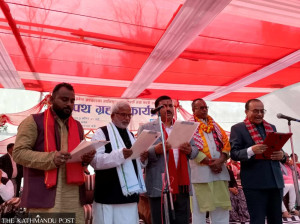Madhesh Province
Fire lines formed to protect community forest in Rautahat
Sundar Prasad Sharma, under-secretary at the Department of Forest and Soil Conservation, said that the country since 2005 has been losing some 200,000 hectares of forest area annually.-by-shiva-puri.jpg&w=900&height=601)
Shiva Puri
Hatemalo Community Forest Users Group in Chandrapur, Saptari, has taken initiatives to form a fire line to prevent wildfires from breaking out in the forest.
According to locals, the community forest has sal saplings planted in 3.5 hectares of forestland in Chandrapur Municipality, and the fire line was formed to protect the sal saplings.
Every year during the dry season, wildfires destroy hundreds of sal trees in the forest. Janga Bahadur Ghalan, vice chairman of the forest users group, said the forest authorities are collaborating with people’s representatives to preserve forest resources.
“This year, we are going to form seven fire lines in the forest area to prevent wildfires from spreading,” said Ghalan. The forest has deployed 12 employees to form fire lines.
The wildfire season in Nepal begins in between November and December and continues until the onset of monsoon. Binod Singh, the division forest officer of Rautahat, said wildfires are common during the dry season from mid-February to mid-June in Tarai.
“Wildfires destroy vegetations and affect wildlife during the dry season. This is why we have brought the concept of scientific forest management,” said Singh, adding that all concerned stakeholders should work together to preserve the forest.
Sundar Prasad Sharma, under-secretary at the Department of Forest and Soil Conservation, said that the country since 2005 has been losing some 200,000 hectares of forest area annually. According to Sharma, the forest fires in 2009 were the deadliest; forty-nine people, including 13 Nepal Army personnel, died while controlling forest fires in Ramechhap district.
In 2016, Nepal lost nearly 1.3million hectares of forest land to forest blaze that also killed 15 people, according to Sharma’s data. A study of the Food and Agriculture Organization (FAO) showed that 90 percent of forest fires are man-made.
“Most forest fires are caused due to sheer human negligence. Discarding cigarette butts without properly stubbing them is the main reason for forest fires,” Singh said. “Locals should be aware of the negative impact of forest fires. They contribute significantly to air pollution by generating haze and smog and have effects on environmental health.”
In 2010, the government introduced the Forest Fire Management Strategy for curbing forest fires. But officials and locals still lack the capacity and tools to contain such fires. The National Disaster Risk Reduction Strategic Action Plan 2018-2030 also talks in detail about controlling and preventing forest fires, but it remains far from implementation.




 16.12°C Kathmandu
16.12°C Kathmandu














